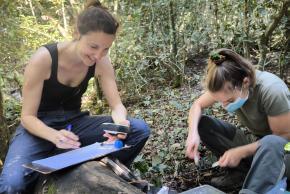Portrait of a researcher awarded the CNRS bronze medal
From the microbiota of urban baboons in South Africa to the genome of bedbugs, from city mice to the mechanisms of natural selection, Laure Segurel weaves evolutionary narratives through genomes. Since 2020, she has been conducting her research at the Laboratoire de Biométrie et Biologie Évolutive (LBBE) in Lyon, where she is involved in several cross-disciplinary projects focusing on biodiversity, adaptation and health. This multi-disciplinary dynamic has been recognized by this year's CNRS bronze medal.
"What I love is deciphering our evolutionary history from genomes. A genome is a treasure trove of information just waiting to be explored, like an open window on the past." A phrase that sums up his scientific approach: putting molecular data into dialogue with lifestyles, environments and the evolutionary trajectories of species.
Projects rooted in our times
Today, the researcher is involved in several structuring projects set up within the LBBE, each linked to major issues of our time: the adaptation of species to environmental changes such as urbanization, cohabitation with wildlife and the links between genetics, microbiota and health.
The One Health concept, both transversal and collective, permeates his approach. "You can't understand human and animal health without looking at the environment. Predicting the evolutionary trajectories of species necessarily requires us to characterize how our environments, particularly anthropogenic ones, are going to evolve."
Among the projects to which she contributes, the one on South African baboons, set up by Virginie Rougeron of the French-South African REHABS laboratory, looks at the impact of urbanization on their intestinal microbiota: do individuals that feed in cities have a different bacterial composition? Another example, led by Sabrina Renaud: sentinel mice, studied to understand how species adapt to the constraints of the urban environment. "It's also about us: What evolutionary pressures does urbanization exert on living beings?"
A third project initiated by Julien Varaldi focuses on the bedbug, originally a bat parasite, which has now specialized on humans: how has it adapted, genetically, to this new host?
Finally, an ANR (French National Research Agency) project she is coordinating, due to start in autumn 2025, is looking at an evolutionary process whose prevalence is still poorly understood: balanced selection, a form of natural selection which, instead of reducing genetic diversity, maintains or even increases it. Using simulations and the analysis of data from several species (primates, birds, flies, butterflies), she will seek to detect these subtle forms of selection.
Tracing the thread back to our origins
While her current research focuses on evolution, conservation and health, it is rooted in an older line of questioning, which she sums up as follows: “How do humans adapt to a changing world?”
Recruited by the CNRS in 2013, she began to explore a new field: microbiota. She set up a comparative study on the subject, contrasting inhabitants of towns and villages in Cameroon. The result: different bacterial compositions, but not necessarily less diverse in the city. A complex balance between infectious pressure in rural areas and metabolic pressure (diabetes, allergies, cancers) in urban areas.
Prior to this, she completed a post-doctorate in Chicago in 2010, focusing on the genetic diversity of chimpanzees. This work marked a first turn towards broader comparative genomics.
But her interest in evolution and diversity goes back even further, to her thesis on genetic anthropology at the Musée de l'Homme. Here, she investigated human social structures in Central Asia : how do geographical, cultural and linguistic constraints shape marriages, migrations and, consequently, genomes ? She then compared herders and farmers, to identify traces of adaptation to new diets and better understand the origins of certain metabolic diseases.
Initially, however, it was through biology that she entered science. But soon, the biological object was no longer enough. What she was looking for were hidden histories: those of human groups, lineages, species and their interactions with the environment.
The LBBE, a breeding ground for evolutionnary histories
Laure Segurel has been based at the LBBE since 2020, where she has found a scientific ecosystem that resonates with her approach: interdisciplinary, rooted in contemporary issues and attentive to the complexity of evolutionary trajectories. Projects are built with several voices, and genomics dialogues with modeling and ecology.
This CNRS medal, more than an individual distinction, shines the spotlight on a research collective. A laboratory where the stories told by genomes meet those of environments, behaviors and human pressures. And where each DNA sequence becomes a new chapter in our shared history.
‘I'm like an archaeologist of the living world, trying to understand how everything came together, in the hope that it will also shed light on the future’.
